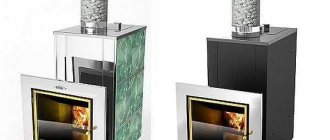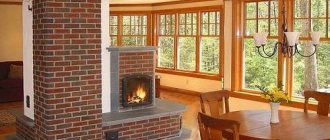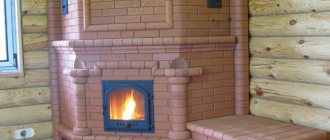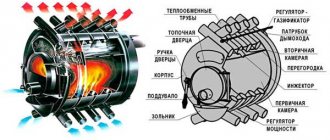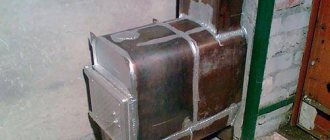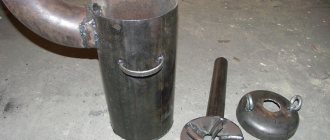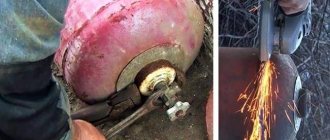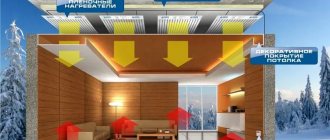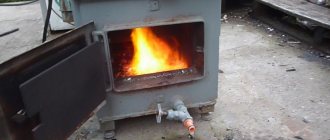Despite the possibility of installing a variety of compact metal stoves, brick heating devices are still very popular among homeowners. Their design is constantly being improved. The classic option is a bell furnace. Read and find out what it is, the principle of its operation, its varieties, design features and advantages. Let's talk about the nuances of determining the thermal power and ordering of such a two-bell stove with a single-burner stove.
Option of a bell-type furnace design Source mtdata.ru
Basic general information
Throughout history, a large number of different models of brick kilns have been created. Among them, the lion's share consists of structures in the construction of which the bell-type principle is used. It is used to create massive stoves that can have a fireplace compartment and a bench. This construction principle is also used in the construction of compact structures. These structures are ideal for small houses.
One of the options for a miniature but effective device is the Kuznetsov furnace. The design got its name in honor of the famous stove maker. This inventor thoroughly refined the furnace design of the bell-type operating principle. Thanks to Igor Viktorovich Kuznetsov, this type of stove became popular in Russia and numerous other countries.
Rules for additional fuel loading
Regular firing of a brick oven is rarely limited to just one fill, which is usually only enough for 6-8 hours of continuous burning. Therefore, most experienced stokers stock up on an additional portion of firewood before lighting the stove. After the first load burns out, they do not wait for “blue lights” to appear on the coals and begin to reload solid fuel into the work area.
Before lighting the stove, it is important to immediately calculate the number of expected bookmarks and prepare an appropriate supply of firewood. The next time you load them, you will need to follow the rules to preserve the accumulated heat and eliminate the possibility of carbon monoxide entering the living room. To quickly ignite new portions, the remnants of the previous stack, along with smoldering coals, are raked in the central part.
Operating principle
The compact bell-type furnace design is simply called “Kuznetsovaya”. In it, combustion products move without obstacles. The heating structure also has other special design differences. It was they who influenced the great popularity of Kuznetsovka.
In Kuznetsovka, combustion products move freely Source remontnik.ru
In the vast majority of brick stoves, the masonry is directly heated from the energy generated as a result of fuel combustion. In other models, heat is transferred to the walls from the smoke, which passes through channels with a complex configuration.
In furnace structures with direct heating of the walls, the heat transfer value is affected by the thickness of the masonry. As it decreases, the heat capacity increases. However, this version of the furnace design constantly needs a large amount of fuel. Otherwise, the large stove will not warm up properly. When the fuel stops burning in it, the structure gradually cools. At this moment, heat is transferred from it to the room atmosphere.
If the stove has a complex configuration of smoke exhaust channels, the structure is heated more evenly. However, more requirements are placed on such a structure. This applies in particular to the height of the chimney. It must provide good traction
A stove with a complex internal structure Source stroyfora.ru
On a note! In stoves with a complex configuration of narrow channels, more soot accumulates. Therefore, they have to be cleaned more thoroughly. In this case, it is necessary to constantly monitor the permeability. Most often, traffic jams form at the turns of smoke exhaust ducts. If they are not constantly removed, then traction worsens significantly. At the same time, there are a lot of turns in such furnace structures.
A bell-type stove for heating a home is almost completely devoid of the listed disadvantages. After all, its design implies the presence of two smoke exhaust channels. At the same time, they are connected to each other. Thanks to their presence, the efficiency of the furnace structure increases. Two connected channels accumulate thermal energy much better.
One of the chimneys is an internal circuit. It is created next to the firebox or even laid out around it. Such a channel remains hot longer because there is also an external circuit in the design. It is through this that the smoke comes out.
Important! The furnace design with internal and external channels cools down more slowly. After all, combustion products move along a complex trajectory before entering the chimney.
Diagram and principle of gas movement in Kuznetsovka Source stroyfora.ru
The two-bell furnace is also distinguished by the presence of 2 chambers, which are heated as a result of the operation of the structure. They are called the lower and upper caps. In the first of them, heated combustion products circulate. The same thing happens in an ordinary bell-type furnace design.
After circulation in the lower hood, the smoke moves to the upper part, where it fills all the free space. As a result, this part of the furnace structure is heated. Only after this the combustion products enter the chimney.
What kind of firewood is suitable
Before preparing the fireplace for fuel, it is advisable to understand the rules for igniting it and find out which firewood is best for the stove. For classic Dutch and Russian stove designs, the type of wood is selected depending on the following factors:
- level of heat transfer from one bookmark;
- duration and intensity of combustion;
- smoke production indicator;
- the amount of ash produced during combustion.
Good firewood should melt quickly, have high heat output and burn almost to the end, without leaving a noticeable amount of waste. All these indicators of “wooden” fuel depend on the type of wood and the quality of its drying.
Completely fresh, freshly cut combustible material is not suitable for heating a stove, since when it is disposed of, a lot of smoke is generated and it will take a very long time to burn.
Another unpleasant consequence of using damp or insufficiently dried firewood is the possibility of severe burns from the saturation of the air with carbon dioxide. To get rid of accumulated moisture, the firewood must first be thoroughly dried. To check the readiness of firewood for use, there is a very simple technique: just knock one log on another and listen to the sound made. Well-dried wood logs, unlike raw logs, have a sonorous sound.
When choosing firewood, it is important to consider the time of its preparation (winter or summer). The highest quality dry fuel is obtained from trees cut down in winter, when the internal movement of sap occurring in them is greatly inhibited. It is strongly not recommended to stock up on inexpensive aspen firewood harvested in the spring and summer months, since the wood during this period has high humidity and requires long-term drying.
Types of bell-type stoves
The Kuznetsov bell furnace can have different designs. After all, the engineer has developed a huge number of variants of such designs. Today there are more than 150 models. With their help, various rooms are heated.
On a note! Existing versions of Kuznetsovok differ in technical characteristics. They also have different functionality. The location of heating hoods has a great influence on all parameters.
Sections of a functional “Kuznetsovka” Source stroyfora.ru
A popular model is the Kuznetsov two-bell furnace, characterized by the location of one bell above the other. This type of heating brick structure has small dimensions, which allows it to be created even in small houses.
"Kuznetsovka" may have one of the following abbreviated names:
- IOK is a stove exclusively for heating.
- HOVIC is a heating structure with a hob. This structure is made of ceramic bricks. At the same time, fire-resistant blocks are not used for laying the firebox.
- OVIK BK is a Kuznetsov brick stove for a wood-burning home, a cooking and heating stove, the design of which includes a side fireplace compartment.
- OVIC L is a heating stove equipped with a hob and a stove bench.
- OVIC ZK is a heating structure with a cooking compartment and a fireplace, which is located in the rear part of the structure.
- PKIK1K – stove with heater.
- RTIK is a Russian traditional bell-type stove design.
- BIC is a heating structure for a bathhouse.
Construction of “Kuznetsovka” in the bathhouse Source ekomeistras.files.wordpress.com
This design can also have an oven. To designate such a structure, an abbreviation is used that contains the letter “D.” Abbreviated names allow you to quickly understand the purpose of a specific structure. Each abbreviation is used to designate a whole model range in which heating structures have similar sizes, shapes, and technical characteristics.
Preparatory work
First of all, you need to choose a place to build a furnace.
The easiest way to do this is before building a house - then both the stove and the building are designed together so that three or at least two rooms are heated. With a ready-made house, the situation is more complicated. In this case, they tend to build the stove into an interior partition, since installing it into a load-bearing wall requires complex calculations and dangerous, time-consuming work (part of the wall will have to be dismantled, keeping the load from being blocked by a system of lintels and columns). You can, of course, limit yourself to a simple wall-mounted arrangement, but then only one room will be heated.
A reinforced concrete foundation must be built at the selected location. Its dimensions must exceed the dimensions of the oven by at least 100 mm on each side. It is not allowed to combine the foundation of the furnace with the foundation of the building - both structures give different settlements and one of the foundations will pull the other along with it, causing it to skew.
A reinforced concrete foundation must be installed under the furnace.
The depth of the foundation depends on the bearing capacity of the soil, the depth of its freezing, and the method of operation of the building (periodically/continuously). Typically, in buildings with year-round habitation of people located on stable ground, the foundation is deepened by 400–600 mm. Crushed stone should be poured onto the bottom of the excavation as a reinforcing layer, and a sand cushion should be placed on top of it.
Then everything is done using traditional technology - they install the formwork, fix the reinforcement frame and fill it with concrete. You should proceed to the construction of the furnace only after the concrete has fully matured and gained sufficient strength - this usually takes about a month.
Determination of the thermal power of bell-type stoves
The operational parameters of a furnace structure are always determined at the first stage of its development. This allows you to design an efficient heating structure that will heat the house well.
In addition to the dimensions, the thermal power of the furnace is always determined. The parameter represents heat transfer. This characteristic must correspond to the dimensions of one or more rooms that will be provided with heat from the stove. During the calculation, heat loss must also be taken into account. They are present even if the building is very well insulated.
Experts also take into account the thickness of the brickwork. This parameter affects the degree of thermal energy accumulation.
The thickness of the oven walls affects heat accumulation Source susaninclub.ru
Only specialists can accurately calculate all the parameters of the furnace structure. Calculations are carried out taking into account the following rules:
- to heat 10 m² of house area, which has high-quality insulation, 0.5 kW of the power of a brick heating structure is consumed;
- in residential buildings built in cold regions, 0.75 kW of furnace power is spent on heating 10 m².
Experts often recommend using ready-made designs for furnace structures. This speeds up the process of building a structure in the house. Although, when turning to professionals, a regular or two-bell heating and cooking stove will be designed in a minimum period of time. After all, the specialists have experience and are well aware of all the nuances of the development of each Kuznetsovka model.
A bell-type stove is often built according to a ready-made and proven design Source baniwood.ru
See also: Catalog of companies that specialize in the design and installation of fireplaces and stoves
The main distinctive features of bell-type stoves
The right choice cannot be made if you do not know the main features of the heating structure. Thus, a bell-type heating stove, the construction of which is often carried out in private homes, differs:
- Almost complete isolation of the firebox from the hood . This is one of the main distinguishing features of Kuznetsovka. The combustion chamber is lined with fire-resistant fireclay bricks. After all, this chamber heats up to 1000 ℃ or even 1200 ℃.
Construction of a stove with fireclay brick firebox Source master-off.net
On a note! Regular and fireclay blocks differ in density. For this reason, a 5mm gap must be created between them, which prevents cracks from forming in the bricks when they heat up and expand. In this case, they do not leave empty space, but fill it with asbestos. Typically this material comes in the form of sheets.
- Lack of direct contact of the water tank and oven chamber with the flame and heated combustion products . The bell-type stove with water heating boiler and oven is a well-thought-out design. After all, the water container and additional compartment are located in the top hood. This type of heating structure was chosen because at the top the maximum temperature is 400 ℃. It prevents the metal from overheating. Therefore, its integrity is not violated. At the same time, this temperature is enough for the entire structure to function fully.
“Kuznetsovka” option with oven Source stovekiv.com
- A shorter chimney than other similar heating structures . A bell-type stove for a bathhouse or residential building must have a chimney, which, first of all, allows combustion products to be removed without violating current rules. This is its main purpose in such a heating design. Only secondarily should it provide the required traction.
- High efficiency, the value of which reaches 80%. Compared to other similar heating structures, this is a good technical characteristic. After all, for similar furnace structures for the same purpose, the efficiency does not exceed 65%.
Important! A bell-type stove with a water heating boiler, the arrangement of which allows you to create a compact firebox, helps to save wood. Thanks to a well-thought-out design, fuel consumption can be reduced by up to 40% compared to stoves in which combustion products are removed directly.
Construction of Kuznetsovka with a water circuit Source build-experts.ru
- The presence of a so-called dry gap in the firebox . Its width usually varies from 2 to 3 cm. The seam is created to improve traction. At the same time, the gap allows you to maintain the required temperature in the combustion chamber. This becomes possible due to the gradual removal of combustion products.
Important! The so-called dry gap can be located anywhere in the brick walls of the heating structure. In this case, the seam must be created in such a way that it represents a channel that is connected to the stove hood.
Stacking and lighting firewood
The traditional approach to stacking firewood and lighting the stove involves preparing a pyramid of logs with a crumpled piece of dry paper placed in the center. Finely planed wood chips are added there, and then the whole thing is set on fire.
When the paper is lit, the wood chips ignite first, after which the fire spreads first to small and then to large logs. The disadvantage of this kindling method is the inability to control the combustion process. The firewood “seizes” all at once and burns entirely, and the process itself proceeds unevenly and quickly. After some of the logs have burned, new portions of firewood are thrown into the stove, which also quickly catch fire and immediately burn out.
The burning time can be artificially increased by changing the method of placing firewood in the firebox. One way to light your stove involves the following procedure:
- The bottom row of logs is placed in the firebox.
- A second row is placed on top, offset to one side by 5-10 cm, forming a small protrusion in relation to the first.
- Next, the third and all subsequent rows are laid.
- A piece of paper is placed at the edge in the ledge area along with birch chips, after which the whole thing is set on fire.
When laying solid fuel based on sawdust, as well as any other dry fuel, individual pieces are not placed close to each other. A small gap must be left between them for the free movement of air masses.
Advantages of bell-type brick kilns
Compared with other similar structures for the same purpose, the bell-type stove has a number of advantages:
- Construction is carried out using less mortar and bricks.
- Construction is faster and easier, because the structure has the optimal number of internal channels for the movement of combustion products. For this reason, a conventional or two-bell Kuznetsov heating and cooking stove, the order of which is understandable even to craftsmen with little experience, has become widespread in private homes.
- Light weight due to fewer building materials required. Therefore, the lightweight structure is built on a small foundation.
Arrangement of a small foundation for Kuznetsov’s stove Source ad-cd.net
- Intensive combustion of fuel in a firebox that is almost completely insulated. For this reason, after burning wood, a minimal amount of solid waste is generated. As a result, the surfaces in the combustion chamber and smoke channels are less covered with soot.
- Easy maintenance. After all, a stove structure of this type is easier to clean from soot due to wider smoke exhaust channels.
- It is not difficult to modernize the selected project if it is necessary to build a heating structure with an oven or a tank for heating water. After all, almost any Kuznetsov brick stove for a wood-burning home has a hood of impressive size.
- Fast heating, which allows you to heat the air in the room to the desired value in a short period of time.
- Uniform heating of all walls. Therefore, the furnace design has high heat transfer.
Any of the Kuznetsov stove options heats up evenly Source brandstove.ru
Usually in bell-type stoves the oven is located at the top. When the oven is located at the bottom, then it is necessarily separated from the firebox by a wall. It protects the metal oven box from excessive heat. The temperature around it does not exceed 400℃. At the same time, inside the oven box it reaches a value of no more than 250℃.
On a note! The hood circulates air around the oven. Therefore, the metal box is heated evenly. This contributes to better baking of the prepared dishes.
Preparation before construction of the stove
After choosing a model of the furnace structure, the master carries out preparatory processes before starting installation of the heating structure. At this stage, a place for the construction of the stove is selected, and individual elements are purchased.
Cast iron parts for the stove Source glavspec.ru
The efficiency of a heating brick structure largely depends on the location of the structure. When choosing it, they are guided by existing fire safety requirements. If the walls of the house are built of wood, then the following rules are observed:
- The minimum distance from the stove to the wooden walls should be 10 cm.
- A heat-resistant basalt or asbestos layer is created between the wall of the building and the stove structure when the heating structure is built into a previously prepared niche.
- The minimum distance from the chimney to the floor beams and rafters should be 15 cm.
Preparatory work also includes the construction of a foundation for the furnace structure. The durability of the entire heating structure depends on its strength.
Important! The reinforced concrete base of the stove should not be monolithically connected to the foundation of the house. After all, the shrinkage of these two structures may differ, because unequal loads will act on them. When they are combined, it is possible that cracks will appear on the walls of the stove and the house due to mutual influence.
The stove foundation is not connected to the base of the house Source ad-cd.net
A bell-type heating structure is a dome stove. Regardless of the name, a building for heating premises can be built in a house that has long been put into operation. However, in this case, the floor is dismantled to construct a pit in which the foundation will be poured.
Important! The perimeter of a monolithic concrete foundation should be 0.5-0.8 cm larger than the base of the furnace.
Sometimes houses are built on a slab foundation. Therefore, the furnace structure also has to be built on the same foundation. To minimize the likelihood of deformation of structures, experts recommend building a lightweight stove. This is exactly what “Kuznetsovka” is.
On a note! It is recommended to bury the reinforced concrete base of the stove structure at least 30-50 cm into the soil.
Necessary materials
Before starting construction, you need to buy all the required materials and prepare the necessary tools in order to stop construction.
Fire brick
Materials for the construction of the furnace:
- refractory bricks - for the construction of a firebox,
- fireproof mastic - for the firebox,
- ceramic brick (grade minimum m150),
- cement, sand and clay - to create the base and brickwork,
- wooden material - for formwork,
- wooden blocks 50x50 - installed in the corners for even masonry,
- metal corners, fittings, wire, plates,
- special foil for the base,
Tools for the construction of “Kuznetsovka”:
- drill with a whisk for mixing the solution,
- shovel and bayonet,
- Master OK,
- big or small grinder,
- large building level,
- roulette,
- bushhammer,
- solution container,
- saw (hand or electric saw).
This is what the minimum set of tools will look like, without which it will not be possible to achieve the desired result.
Ordering of Kuznetsov's furnace design
One of Kuznetsov’s popular furnace structures is a design with two hoods. Its frequently encountered modified version is a stove called the “Big Little One.”
This model is a 2-bell Kuznetsov stove with a hob, which has one burner. Although there may be 2 of them. The presence of one burner allows you to build a stove that will have a larger lower hood. Thanks to this modernization, a structure with increased heat transfer is obtained. Therefore, the room in the house will heat up faster.
When erecting a two-bell structure with one burner, 32 rows of bricks are laid. The heating structure is an effective Kuznetsov stove, the order of which is as follows:
- 1 row of 18 bricks. The laying is carried out on a waterproofing layer laid on a prepared concrete base. The first continuous row is created strictly along the horizon and the level of the finished floor.
The first continuous row of a brick stove Source tproekt.com
Important! The seams between the bricks are made identical with a width of 5 mm.
- 2 row of 11 bricks. When installing the blocks, the base of the lower bell is formed and the ash compartment begins to be laid out. At the same stage, a door for cleaning the lower area of the hood and a similar design of the ash chamber are secured.
- 3 row of 11.5 bricks. When laying the blocks, the corners of 2 brick fragments are pressed together to form an opening under the door, which will allow for further cleaning of the hood.
- 4 row of 14 bricks. Mounted blocks cover the openings under the door of the lower hood and the ash compartment. The smoke exhaust channel, which is located behind the ash pan, is also partially closed in front and behind. In this case, a hole of 26*26 cm is left above the blower chamber.
- 5 row of 14.5 bricks. When laying 2 blocks, the upper surface is cut off at an angle so that the grate can be laid later. At the same time, it will be removed onto the protruding brick blocks of the previous row.
When laying a furnace, it is necessary to change the shape of some bricks Source pvsm.ru
At this stage, the top of the lower cap is divided into 2 channels by the brick. The near passage is necessary to connect this part of the furnace with the upper hood, and the distant channel is subsequently equipped with a valve, which will allow the heating structure to be used in the summer. The dividing brick at the front and bottom is cut diagonally so that the smoke can freely escape into the channel.
- 6 row of 12 bricks. At this stage, the firebox door is secured. The gaps between it and the bricks are sealed with heat-resistant material. Wire is used to secure the door.
- 7 and 8 row of 11.5 bricks. When installing blocks, a 20mm gap is left in the area of the far right corner of the firebox.
- 9 row of 12 bricks. Block elements cover the firebox door. The blocks above it are cut at an angle. When installing this row, maintain a gap in the far corner. To complete this stage of work, take 1 more brick, the right side of which is cut off from above and below so that it fits the previously laid blocks.
When laying the 9th row, the firebox opening is blocked Source otopimdom.ru
- 10 row of 12.5 bricks. When laying blocks in the slab area, elements with cutouts are used. They will allow you to secure a 5 mm thick metal hob and a 3 mm asbestos gasket. In this case, the level of the slab should be 4 mm below the surface of the bricks. When laying the 10th row, a 6 cm wide passage is also made. It is created in the right corner of the firebox. It is needed to connect to the channel of the lower cap.
- 11 row of 12 bricks. Construction of the stove continues by forming a cooking compartment.
- 12-15 row of 12 bricks. They continue to lay out the cooking chamber and chimney channels.
- 16 row of 17 bricks. During installation, cover the lower hood and the right and left walls of the cooking compartment with blocks cut from the ends. Only smoke exhaust channels are not blocked. The valve for summer use of the stove is also attached here. This stage ends with the installation of 2 additional bricks above the slab.
- 17 row of 17 bricks. The stove area is covered with entire brick blocks.
- 18 row of 11.5 bricks. Form a base for further construction of the upper cap. Two doors are also installed here for cleaning it.
During installation, the 18th row forms the basis for the upper cap. Source stroimpech.rus
- 19 rows of 11.5 bricks. Raise the walls of the upper part of the structure.
- 20 row of 11.5 bricks. Close the doors for cleaning the oven.
- 21-27 row of 13 bricks. Lay out the main smoke exhaust channel. The lowest bricks of the 21st row are trimmed so that combustion products can smoothly turn into the chimney.
- 28 row with 13 bricks. They continue to form the main smoke exhaust channel and prepare a place with cutouts for installing the valve.
- 29 row of 19 bricks. The entire area of the furnace structure is covered with blocks. The corners of some of them are trimmed to increase the strength of the structure. Only the smoke hole is left open.
- 30 row of 17 bricks. The stove area is covered with entire blocks, with the exception of the smoke exhaust duct.
- 31 and 32 row of 5 bricks. They create the basis for a mounted chimney.
How to make it
I won’t tire of repeating that there is nothing complicated. Therefore, how to fold a stove with your own hands? Elementary. The diagram above shows how the air should circulate. It zigzags from bottom to top
And this is very important, you can make a stove beautifully without worrying about how it is built inside, but you cannot guarantee that after its operation carbon monoxide will not fill the entire room
Therefore, I advise you to try its construction on a construction set before making a stove. This way it will be clearer how to do it correctly with your own, albeit not entirely experienced, but hopefully still somewhat golden hands.
To build a furnace you need:
- good quality drawings,
- brick,
- clay,
- sand,
- cement,
- firebox,
- grates, gratings.
By the way, using the designer, you can also calculate the number of bricks for our stove.
Preparatory stage
Naturally, you need to start from the foundation. It follows the contours of our structure, its depth should be at least 70 centimeters. I have already told you in one of the articles how to make a high-quality foundation. I won’t repeat myself, but let me remind you that it takes some time to completely harden. Therefore, having made the foundation, let it stand for a while. By the way, I do not recommend connecting the stove foundation to the brownie foundation. These must be completely different structures.
How to work with clay?
If a cement mortar with sand and crushed stone or ready-made concrete is quite suitable for the foundation, then clay is needed for laying a brick oven. Clay must meet certain requirements:
- Be sure to be clean and free of soil.
- Creamy consistency.
The clay is cleaned and then filled with water. After approximately 5 - 7 days, drain off the excess liquid and mix the finished clay with sand in a ratio of 1:3. The finished mortar can be used for laying bricks.
Brick
The brickwork of the stove involves the use of two types of bricks. For external masonry, ordinary clay 250/120/65 mm is suitable. For internal use fireclay ShB-8 and Sh-5 standard sizes. Brick consumption can be calculated as follows: the number of bricks in the first row is multiplied by the number of rows, the result is multiplied by the fill factor (0.8).
For a pipe, bricks are needed at the rate of 4 to 6 pieces per row multiplied by the number of rows.
Masonry
We lay a sheet of roofing felt on the foundation with our own hands, then pour a small amount of clay mixture, level it and lay the first preparatory row. And only the next day it will be possible to begin interior laying.
The standard row of the stove has a height of 7 centimeters with a seam thickness of 5 mm. When making internal brickwork, you need to make marks in certain places (the drawings indicate them).
It is important to create gaps. Otherwise, the outer masonry will be torn apart by the inner, expanding masonry.
The main task is to use your hardworking hands to make the internal brickwork floating and not connected to the external one. Then, when heated, it will expand in all directions without interfering with the outside of the oven.
We coat the inside of the oven with our own hands with an asbestos-cement mixture, or with a clay solution, it is important that there are no voids. This is how we will increase the fire safety of our own masterpiece with our own hands.
All furnace metal parts are installed with a gap of 5 mm. If the design of the stove requires the presence of a stove, then it must be placed in a pre-made brick nest in one of the lower rows. External brickwork must be reinforced.
I always do one row a day, and when it comes to installing metal parts, I can take a break for 2-3 days after installing them. But the stoves that I made with my own hands last a very long time. I advise you not to rush, it’s better to do it more slowly, but more reliably. And everything will work out!
Briefly about the main thing
The bell-type stove was thoroughly developed by engineer Kuznetsov. It has two connected smoke channels. One of them is an internal circuit, and the other is used to remove combustion products outside the structure. The two-channel system allows the stove to cool more slowly.
A design scheme with two caps has also been developed - a lower and an upper chamber. In each of them, combustion products heat the furnace structure and only then go outside.
There are designs of bell-type stoves only for heating a house or bathhouse, with a fireplace, hob, stove bench, and air heater. All of them have high efficiency - approximately 80%. They are quickly erected by professionals. The thermal power of these stoves is 0.5-0.75 kW per 10 m².
Structures are erected on a monolithic concrete foundation. Their ordering is carried out strictly according to schemes that have proven their effectiveness.
The best tree species for making firewood
To light a stove, hardwood is considered the most suitable. Firewood made from them has a high density of fiber structure. They guarantee long burning and high heat transfer. The following types of wood belong to the category of deciduous varieties:
- oak;
- Linden;
- willow, ash and a number of other trees, including rare and expensive alder in most regions of Russia.
The listed types of firewood are suitable for a stove, a garden smokehouse, as well as a fireplace or fireplace installed in a country house. Due to the special properties of these deciduous trees, when they are burned, a unique aroma is felt.
The second place in quality is occupied by coniferous wood - pine and spruce logs. As a rule, they burn well, but they smoke very often and during combustion they form a large amount of soot - this is explained by their high resin content. Other disadvantages of spruce and pine wood include its high rate of burning, which limits the amount of heat received.
